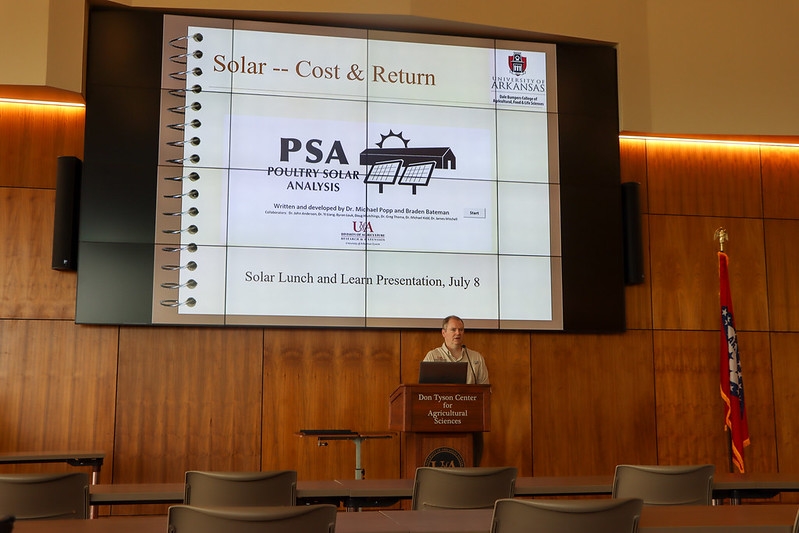
Poultry producers considering use of renewable energy in their operations will have a free tool this fall to help them determine whether solar is right for them.
Yi Liang, associate professor of biological and agricultural engineering and a researcher in the Center of Excellence for Poultry Science, conducted solar energy research in 2021 on an Arkansas poultry production operation and found it offered significant savings.
The poultry grower saved more than 90 percent off his annual electricity expense, Liang said. He paid only account charges — between $15 and $25 per month — in 11 out of 12 months of utility bills in 2021.
The up-front investment of solar technology varies from operation to operation. Michael Popp, professor of agricultural economics and agribusiness for the Arkansas Agricultural Experiment Station, said it could be a pricy endeavor, but one that can help a grower's balance sheet in the long run.
The Agricultural Experiment Station is the research arm of the U of A System Division of Agriculture. The Center of Excellence for Poultry Science includes both research and extension activities of the division.
"We have analyzed poultry farm installations ranging in installation cost between $250,000 and $600,000," Popp said. Associated 30-year total profit in today's dollars ranged from $75,000 to $280,000 for those size installations.
"What you are doing is replacing part of your electricity bill with up-front known costs. You know how much electricity you will generate; you know your depreciation, insurance, interest and property tax cost when you install," he said. "As such, solar panels reduce your exposure to electricity cost volatility."
Their analysis included tax credits and, to a much lesser extent, grants from REAP, the Rural Energy for America Program.
Decision Assistance
The data inspired Popp and Liang to develop an online decision support software tool to help growers assess whether solar is feasible for their farms. Popp said he wanted to have the Poultry Solar Assessment tool available for download in October.
"The Poultry Solar Assessment tool uses farm-specific information to estimate system size as well as appropriate electricity rates on the basis of the last 12 months of electric bill information," Popp said. "The user can then choose financing terms, as well as how long they think it would take for them to realize income-tax-saving benefits."
Popp has developed a line of decision support tools that help Arkansas farmers easily analyze the advantages and values of choices they must make in every segment of the state's agricultural industry. They are available for free download at agribusiness.uark.edu/decision-support-software.
Solar Outreach
Liang and Walter Bottje, poultry science physiologist, hosted an educational program in July to debut the Poultry Solar Assessment tool and share the benefits of utilizing solar energy in poultry production.
"Adding solar technology is a way to lower the cost of production and displace fossil fuel associated with electricity generation with a renewable resource — sunshine," Popp said during the event. "Doing this cost effectively, given current government tax benefits, is an added advantage."
As part of the program, Marvin Childers, president of The Poultry Federation, gave a presentation on net metering and legislation surrounding solar energy in Arkansas.
Net metering is a method of billing electric utility customers who use both the power generated by their own renewable energy, such as solar panels, as well as power supplied by an electric company. When a customer produces more electricity than they consume, the excess energy is transmitted to the company's grid, where it's used by other customers. The customer is credited for the excess energy they transmitted to the company's power grid.
"The additional feature of the Arkansas net meter policy includes meter aggregation, meaning the customers can offset all meters under their name using a solar array. This is attractive for agricultural producers since they have meters for different operations and in various locations," Liang said.
Liang said the Center of Excellence for Poultry Science is planning another solar information event in the fall. It will provide another opportunity to understand the technical and economic aspects of solar technology and ask questions about it.
Topics
Contacts
Jessica Wesson, communications manager
Department of Poultry Science
479-575-3327, jlwesson@uark.edu